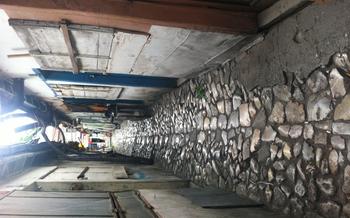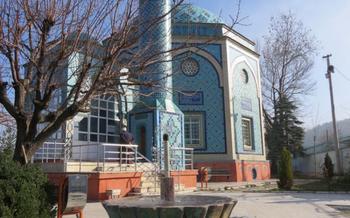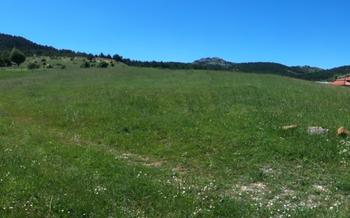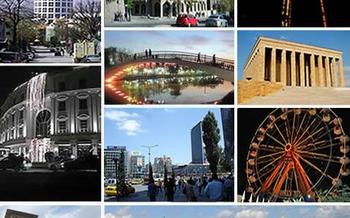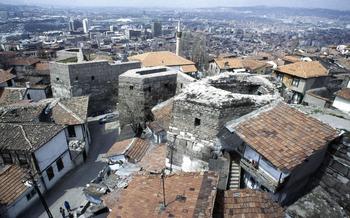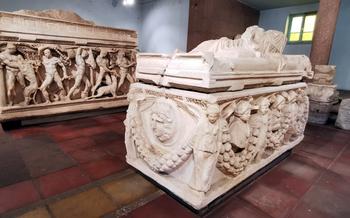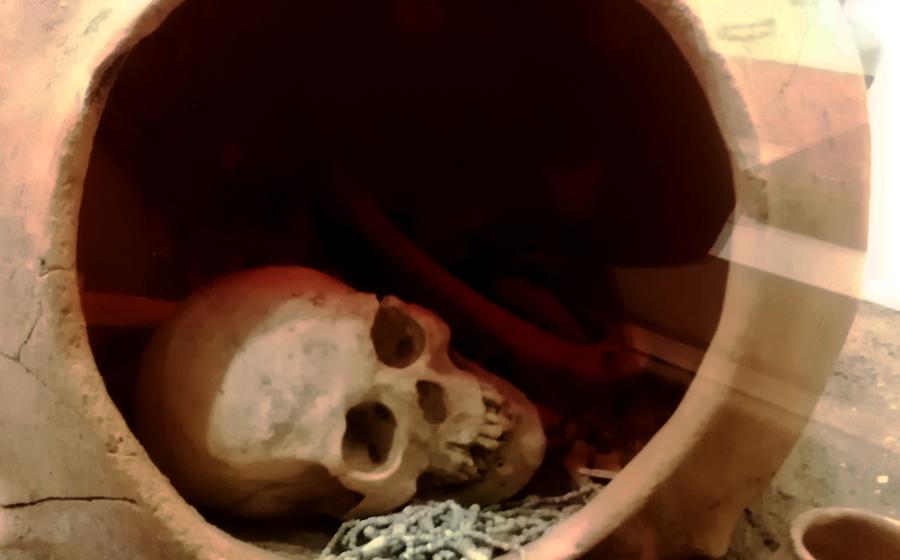
Oğuzhan Mausoleum a historical tomb in Çorum
- Oğuzhan Mausoleum: A Majestic Tomb in Çorum
- Historical Context: The Legacy of Oğuz Kağan
- Architectural Features: A Symbol of Power and Prestige
- Cultural Significance: A Symbol of National Identity
- Location and Accessibility: A Historical Gem in Çorum
- Visiting Hours and Admission Fees: Planning Your Pilgrimage
- Exploring the Mausoleum's Environs: A Journey Through History
- Historical Background of Çorum: A Crossroads of Civilizations
- Architectural Wonders of Çorum: A Tapestry of History
- Natural Beauty of Çorum: A Hidden Gem
- Festivals and Events: Celebrating Çorum's Spirit
- Accommodation Options: Resting in Çorum
- Transportation within Çorum: Navigating the City
- Insider Tip: Unveiling Local Secrets
Oğuzhan Mausoleum: A Majestic Tomb in Çorum
Deep in the heart of Çorum lies a historical gem that embodies the legacy of the Oghuz Turks, the ancestors of modern-day Turks. The Oğuzhan Mausoleum stands as a majestic tribute to Oğuz Kağan, the legendary leader who unified the Oghuz tribes and is revered as the father of the Turkish nation. This architectural masterpiece not only showcases the grandeur of Turkish history but also holds immense cultural significance for the Turkish people.
As visitors approach the mausoleum, its octagonal shape and intricate stonework create an aura of awe and reverence. Inside, the central chamber exudes a sense of tranquility and spirituality, adorned with symbolic carvings, inscriptions, and tilework that narrate the epic tale of Oğuz Kağan and his descendants.
The Oğuzhan Mausoleum serves as a poignant reminder of the rich heritage and cultural identity of the Turkish nation. It is a symbol of unity, strength, and resilience that continues to inspire generations. Whether you're a history buff, a cultural enthusiast, or simply seeking a unique travel experience, a visit to the Oğuzhan Mausoleum is an absolute must.
Historical Context: The Legacy of Oğuz Kağan
Origins and Legends:
Oğuz Kağan, the legendary leader of the Oghuz Turks, is shrouded in mystery and myth. According to Turkish mythology, he was a descendant of Noah and the founder of the Oghuz tribes. His origins are often traced back to Central Asia, where he is believed to have lived in the 8th century AD.
Tribal Confederation:
Under Oğuz Kağan's leadership, the Oghuz tribes united to form a powerful confederation. This confederation played a pivotal role in the history of Central Asia, influencing the political and cultural landscape of the region. The Oghuz tribes were known for their nomadic lifestyle, their military prowess, and their unique customs and traditions.
Migrations and Conquests:
Throughout the centuries, the Oghuz Turks embarked on a series of migrations and conquests. They expanded their territory from Central Asia into Anatolia and beyond. Their military achievements and strategic alliances with other Turkic tribes contributed to the rise of the Ottoman Empire, which would eventually become one of the most powerful empires in the world.
Cultural Influences:
The Oghuz Turks left a lasting cultural legacy on the regions they inhabited. Their language, customs, and traditions had a profound impact on the development of Turkish culture and identity. The Oghuz Kağan epic, which narrates the legendary life and deeds of Oğuz Kağan, is considered a masterpiece of Turkish literature and a symbol of national pride.
Architectural Features: A Symbol of Power and Prestige
The Oğuzhan Mausoleum stands as a testament to the architectural prowess of the Seljuk dynasty. Its striking exterior features an octagonal shape, a symbol of perfection and eternity in Islamic architecture. The mausoleum's facade is adorned with intricate stonework, showcasing the skilled craftsmanship of the era. The entrance to the mausoleum is marked by a monumental portal, flanked by two minarets that reach towards the sky.
The interior of the mausoleum is equally impressive, featuring a central chamber with a domed ceiling. The chamber is adorned with intricate carvings and inscriptions, including verses from the Quran and praises of Oğuz Kağan. The mausoleum also features a number of smaller chambers, which were likely used for religious ceremonies and rituals.
The architectural features of the Oğuzhan Mausoleum reflect the power and prestige of the Seljuk dynasty. The mausoleum's octagonal shape, intricate stonework, and monumental portal all contribute to its imposing presence. The interior of the mausoleum is equally impressive, with its domed ceiling, intricate carvings, and inscriptions.
Overall, the Oğuzhan Mausoleum is a remarkable example of Seljuk architecture. Its striking exterior and impressive interior make it a must-see for anyone interested in Islamic architecture or Turkish history.
Cultural Significance: A Symbol of National Identity
Oğuzhan Mausoleum holds immense cultural significance as a symbol of Turkish national identity and unity. Oğuz Kağan, the legendary leader of the Oghuz Turks, is revered as a national hero in Turkey. The mausoleum serves as a testament to his legacy and the deep-rooted cultural heritage of the Turkish people.
The Oğuz Kağan epic, a central narrative in Turkish mythology, plays a crucial role in shaping Turkish cultural identity. It recounts the origins, migrations, and heroic deeds of Oğuz Kağan and his descendants. The epic instills a sense of pride and unity among Turks, who trace their lineage back to the Oghuz tribes.
The mausoleum is also a site of pilgrimage for many Turks, who visit to pay their respects to Oğuz Kağan and seek blessings. Visitors perform various rituals, such as tying ribbons or leaving offerings at the mausoleum, as a way of expressing their devotion and seeking divine favor.
In modern-day Turkey, the Oğuzhan Mausoleum continues to be a symbol of national pride and cultural heritage. It serves as a reminder of the rich history, traditions, and unity of the Turkish people. The mausoleum's enduring significance underscores its role as a cornerstone of Turkish national identity.
Location and Accessibility: A Historical Gem in Çorum
Çorum is strategically situated in the Central Anatolia region of Turkey, offering easy access from major cities. The closest airport is Amasya Merzifon Airport (MZH), located approximately 65 kilometers away. From the airport, travelers can take a taxi or rent a car to reach Çorum. Alternatively, visitors can take a train or bus from Ankara, the capital city of Turkey, which is approximately 250 kilometers away. Once in Çorum, the Oğuzhan Mausoleum is easily accessible by public transportation or taxi from the city center. The mausoleum is open to visitors daily, providing ample opportunities to explore its historical and cultural significance. Whether arriving by air, rail, or road, Çorum's accessibility makes it a convenient destination for history enthusiasts and travelers seeking unique cultural experiences.
Visiting Hours and Admission Fees: Planning Your Pilgrimage
Visiting the Oğuzhan Mausoleum is a remarkable experience that allows visitors to immerse themselves in history and culture. The mausoleum is open to the public daily, providing ample opportunities for exploration and contemplation. Regular visiting hours typically run from 9:00 AM to 5:00 PM, with possible seasonal variations. It is advisable to check the official website or contact local tourism authorities for the most up-to-date information on opening hours and any special arrangements.
Admission fees are charged for both domestic and international visitors, with separate rates for adults, students, and children. Fees are generally affordable and serve to support the preservation and maintenance of this historical site. Visitors are encouraged to purchase tickets at the entrance gate or through authorized online platforms.
Guided tours are available for those seeking a deeper understanding of the mausoleum's history and significance. These tours are typically led by knowledgeable guides who provide insightful commentary and anecdotes, enhancing the overall experience. Visitors can inquire about guided tours at the information desk or through local tour operators.
Photography is permitted within the mausoleum, allowing visitors to capture the beauty and grandeur of this architectural marvel. However, it is essential to be respectful and mindful of other visitors when taking photographs. Flash photography or the use of tripods may be restricted in certain areas to preserve the integrity of the mausoleum.
Exploring the Mausoleum's Environs: A Journey Through History
Beyond the walls of the Oğuzhan Mausoleum lies a treasure trove of historical and cultural experiences waiting to be discovered. A short stroll from the mausoleum, visitors can immerse themselves in the rich history of Çorum at the Çorum Archaeological Museum. The museum houses a vast collection of artifacts, including ancient coins, pottery, and sculptures that provide a glimpse into the city's diverse past.
For those seeking a deeper connection with nature, the scenic Gölcük Nature Park offers a serene escape just a few kilometers from the mausoleum. The park's tranquil lake, lush forests, and diverse wildlife provide an ideal setting for hiking, picnicking, or simply relaxing in the embrace of nature.
History buffs can embark on a journey through time at the nearby Çorum Castle, which dates back to the Byzantine era. The castle's imposing walls, towers, and dungeons offer a glimpse into the city's turbulent past and provide stunning panoramic views of the surrounding landscape.
To experience the vibrant spirit of Çorum, visitors can explore the bustling Bedesten Bazaar, a labyrinth of narrow streets lined with shops selling traditional handicrafts, carpets, and souvenirs. The bazaar is a feast for the senses, with the aroma of spices, the sound of haggling merchants, and the vibrant colors of the displayed goods creating a lively and authentic atmosphere.
Historical Background of Çorum: A Crossroads of Civilizations
The city of Çorum, where the Oğuzhan Mausoleum is located, has a rich and diverse historical background, having served as a crossroads for different civilizations throughout history. Archaeological findings suggest that the area has been inhabited since the Neolithic period. In ancient times, Çorum was part of the Hittite Empire, and later came under the rule of the Phrygians, Lydians, and Persians.
During the Roman period, Çorum was known as Gordion and served as an important administrative center. The city's strategic location on the Silk Road contributed to its prosperity and growth. The Romans left behind a significant legacy in Çorum, including the ruins of a Roman theater and an aqueduct.
In the Byzantine period, Çorum was known as Gangra and became a major center of Christianity. The city was home to several churches and monasteries, some of which still stand today. During the Seljuk period, Çorum was conquered by the Turks and became part of the Seljuk Sultanate of Rum. The Seljuks built several mosques and madrasahs in the city, contributing to its Islamic heritage.
In the Ottoman period, Çorum remained an important administrative center and was known for its production of silk and carpets. The city was also a center of learning, with several madrasahs and libraries. Çorum's rich history and cultural heritage are reflected in its diverse architecture, which includes buildings from different periods and civilizations.
Architectural Wonders of Çorum: A Tapestry of History
Çorum is home to a diverse range of architectural wonders that reflect its rich historical heritage. Among these landmarks, Çorum Castle stands as a testament to the city's resilience and strategic importance. Built atop a hill overlooking the city, the castle offers panoramic views of the surrounding landscape. Its imposing walls and well-preserved towers speak to the engineering prowess of its builders.
Ulu Mosque, with its elegant minarets and intricate tilework, is another architectural masterpiece that graces the city. Built during the Seljuk period, the mosque showcases the fusion of Islamic and Anatolian architectural styles. Its spacious courtyard and serene atmosphere invite visitors to pause and reflect amidst the bustling city.
The Bedesten Bazaar, located in the heart of Çorum, is a vibrant tapestry of colors and textures. This covered market, dating back to the Ottoman period, features a maze of narrow streets lined with shops selling traditional handicrafts, carpets, and jewelry. The air is filled with the scent of spices and the sounds of haggling merchants, creating a vibrant and immersive shopping experience.
Finally, the Armenian Church, with its unique blend of Armenian and Ottoman architectural elements, stands as a testament to the city's diverse cultural heritage. Its intricate stone carvings and colorful frescoes offer a glimpse into the rich history of the Armenian community in Çorum.
Natural Beauty of Çorum: A Hidden Gem
Beyond its rich history and cultural heritage, Çorum boasts an array of natural wonders that captivate visitors with their unspoiled beauty and tranquility. Embrace the serenity of Ilıca Waterfall, a cascading marvel surrounded by lush greenery, inviting you to immerse in its refreshing mist. Venture into Gölcük Nature Park, where diverse flora and fauna thrive, offering a sanctuary for nature enthusiasts. For those seeking adventure, Köprülü Canyon beckons with its breathtaking vistas, challenging hiking trails, and opportunities for adrenaline-pumping activities like rafting and canyoning. Find solace by the tranquil waters of Hirfanlı Dam, an oasis of tranquility amidst picturesque landscapes, perfect for unwinding and connecting with nature.
Festivals and Events: Celebrating Çorum's Spirit
Çorum is not just rich in historical and natural attractions; it also boasts a vibrant calendar of festivals and events that showcase the city's lively spirit and cultural heritage. One of the highlights is the Çorum International Folk Dance Festival, where dancers from all over the world gather to perform their traditional dances, creating a kaleidoscope of colors and rhythms. The Çorum Cherry Festival is a celebration of the region's famous cherries, featuring food stalls, live music, and fun activities for the whole family. If you're interested in exploring the diverse tourism offerings of Çorum and its surrounding regions, don't miss the Çorum International Tourism Fair, where you can interact with local businesses and learn about upcoming events and attractions. Finally, immerse yourself in the local culture by attending traditional village festivals, where you can witness authentic music, dance, and food, offering a glimpse into the heart of Çorum's rural communities.
Accommodation Options: Resting in Çorum
Çorum offers a diverse range of accommodation options to suit different budgets and preferences. For a comfortable and luxurious stay, visitors can choose from a selection of hotels that cater to both business and leisure travelers. These hotels often provide modern amenities, spacious rooms, and convenient locations near major attractions.
For budget-conscious travelers, hostels offer a social and affordable alternative. These shared accommodations provide a great opportunity to meet fellow travelers and experience the local culture. Hostels in Çorum typically offer dormitory-style rooms as well as private rooms, ensuring a comfortable and budget-friendly stay.
For those seeking a more authentic experience, guest houses offer a cozy and welcoming atmosphere. These traditional Turkish houses have been converted into charming accommodations, providing a unique glimpse into the local way of life. Guest houses often offer delicious home-cooked meals and personalized recommendations for exploring the city.
For a closer connection with nature, camping is an excellent option. Designated camping areas are available in and around Çorum, providing a peaceful retreat surrounded by stunning scenery. Camping allows visitors to enjoy the tranquility of the outdoors while still being within easy reach of the city's attractions.
Transportation within Çorum: Navigating the City
Çorum offers a range of transportation options to explore the city and its surroundings. Public transportation, including buses and taxis, is readily available and provides a convenient and affordable way to get around. Buses follow designated routes and can be hailed from designated stops, while taxis are widely available for hire. For those who prefer a more independent mode of transportation, renting a car is a great option. Several car rental agencies are located in the city, offering a variety of vehicles to suit different needs and budgets. Visitors can enjoy the freedom and flexibility of exploring Çorum and its surrounding areas at their own pace. For those who prefer a more active and eco-friendly way to explore, bicycle rentals are also available. Several bike rental shops are located throughout the city, offering a variety of bicycles to suit different preferences and abilities. Cycling is a great way to discover hidden gems and experience the city from a unique perspective. Finally, Çorum is a very walkable city, allowing visitors to explore its charming streets and neighborhoods on foot. Walking is a great way to soak in the local atmosphere, discover hidden gems, and interact with the friendly locals.
Insider Tip: Unveiling Local Secrets
Hidden Gems: Explore the hidden wonders of Çorum, such as the picturesque villages of Kargı and Ortaköy, which offer a glimpse into traditional Turkish rural life.
Local Cuisine: Indulge in the culinary delights of Çorum by savoring traditional dishes like keşkek, a hearty wheat and meat stew, and mantı, delicious Turkish dumplings.
Cultural Etiquette: Respect Turkish customs and traditions by dressing modestly, greeting people with a handshake or a slight bow, and removing your shoes when entering a mosque or a private home.
Off-the-Beaten-Path Experiences: Venture off the beaten path by visiting the Çorum Archaeological Museum, which houses a rich collection of artifacts from the region's ancient past, or exploring the scenic landscapes of the Yozgat-Çorum Nature Park.


